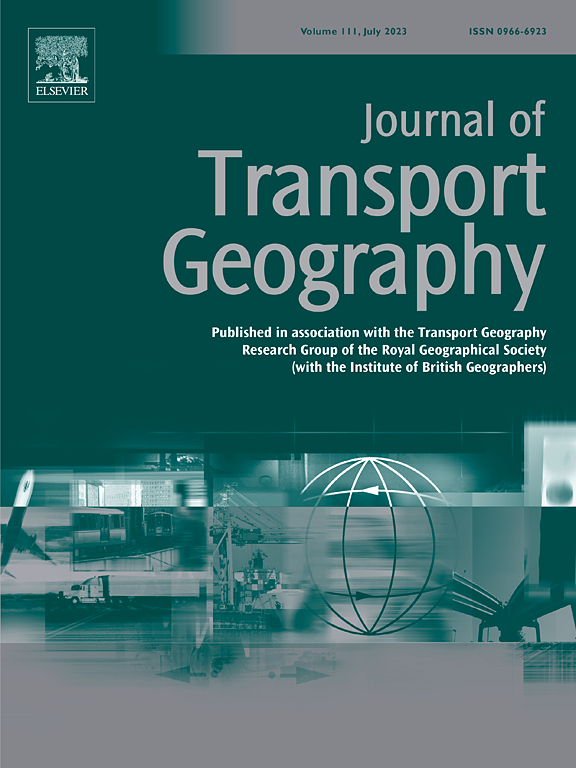How is grocery shopping completed in households with children? Gender gaps and typologies of grocery shopping in four Canadian metropolises
IF 5.7
2区 工程技术
Q1 ECONOMICS
引用次数: 0
Abstract
Grocery shopping is important household labor that directly impacts diet quality and related downstream health outcomes. Like other household tasks, it is usually divided unequally in opposite-gender households, with women doing more grocery shopping than men. However, common indicators used to identify gender gaps, like activity frequency and duration, are unable to sufficiently depict the full picture of the constraints faced by women during grocery shopping activities. This is especially evident for women in households with children, who often share more care-related labor. To address this gap, this paper examined the gender differences in grocery shopping activities across multiple dimensions, including frequency, duration, grocery store types, travel modes, the presence of companions, timing of shopping, and trip chaining. Drawing upon the Time Use & Food Habits survey conducted in four Canadian metropolitan areas in 2021, the results show that women and men in households with children exhibited different characteristics of grocery shopping across multiple dimensions. Women compared to men not only spent more time shopping, but also were less likely to drive to stores and more likely to shop during working hours and with companions. Gender differences were further compared among different classifications of grocery shopping patterns identified through latent class analysis. Various gender gaps were found across different classifications, with women shopping with others possibly having some of the most complex constraints. Multinominal logistic regression shows that shopping with others was associated with identifying as female, being relatively lower socioeconomic status, having greater housework responsibilities, and living in areas with higher grocery store density. Overall, this study provides evidence of nuanced gender gaps of grocery shopping in multiple dimensions, within different groups of people, and across a range of cities of various sizes.
在有孩子的家庭中,杂货店是如何完成的?加拿大四个大都市的性别差异和杂货购物类型
杂货店购物是一项重要的家庭劳动,它直接影响饮食质量和相关的下游健康结果。与其他家务一样,在异性家庭中,这一任务通常分配不均,女性比男性更多地购买食品杂货。然而,用于确定性别差距的常用指标,如活动频率和持续时间,无法充分反映妇女在杂货购物活动中所面临的限制。这对于有孩子的家庭中的女性来说尤其明显,她们往往分担更多与护理相关的劳动。为了解决这一差距,本文从多个维度考察了杂货店购物活动的性别差异,包括频率、持续时间、杂货店类型、旅行模式、同伴的存在、购物时间和旅行链。利用时间& &;2021年在加拿大四个大都市地区进行的食品习惯调查显示,有孩子的家庭中的女性和男性在多个维度上表现出不同的杂货购物特征。与男性相比,女性不仅花更多的时间购物,而且开车去商店的可能性更小,而且更倾向于在工作时间和有同伴的情况下购物。通过潜在类分析进一步比较了不同杂货购物模式分类的性别差异。在不同的分类中发现了不同的性别差异,与他人一起购物的女性可能有一些最复杂的限制。多项逻辑回归显示,与他人一起购物与女性身份、相对较低的社会经济地位、更多的家务责任以及生活在杂货店密度较高的地区有关。总的来说,这项研究提供了证据,证明在不同的人群中,在不同规模的城市中,在杂货店购物中存在细微的性别差距。
本文章由计算机程序翻译,如有差异,请以英文原文为准。
求助全文
约1分钟内获得全文
求助全文
来源期刊

Journal of Transport Geography
Multiple-
CiteScore
11.50
自引率
11.50%
发文量
197
期刊介绍:
A major resurgence has occurred in transport geography in the wake of political and policy changes, huge transport infrastructure projects and responses to urban traffic congestion. The Journal of Transport Geography provides a central focus for developments in this rapidly expanding sub-discipline.
 求助内容:
求助内容: 应助结果提醒方式:
应助结果提醒方式:


